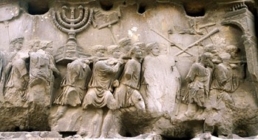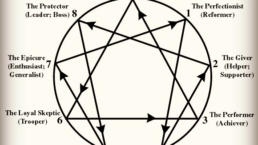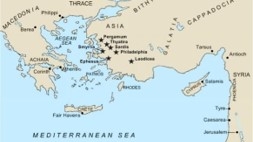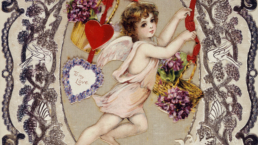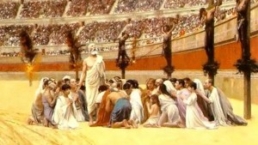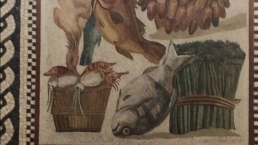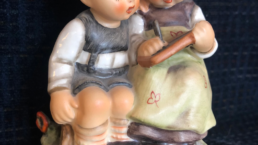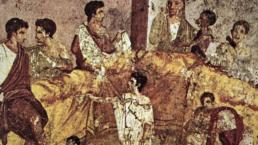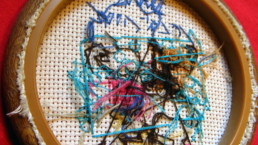An author's dilemma – Slavery in ancient Rome
When we attempt to relate to another culture, especially one existing over 2500 years ago, confusion, bewilderment, and in the case of slavery, rage is bound to happen. The culture of slavery is an issue authors encounter when writing about the Roman empire, and it is a treacherous one to address.
(Collared Roman slaves / Ashmolean Museum, Photo by Jun, Wikimedia Commons)
It is difficult to approximate the number of slaves in 96 A.D. the year my mystery novel, Obedient Unto Death, takes place. Historians and archeologists estimate up to one out of three people were in bondage throughout the far-flung geography of the Roman Empire during that period. Many of our current western Christian principles, values, and beliefs would have been ridiculed or were non-existent in ancient cultures. The Ancient Roman reaction to slavery, rape, infanticide, murder, marriage, and death was not the same as our "enlightened" responses. How does one conflate the horrors of human bondage with the Romans' causal acceptance of the pervasive practice? Captivity was so engrained in the fabric of Roman life that it was accepted as "normal," not only by the ruling elite but often by the enslaved themselves.
In my novel, I have chosen to present slavery as individual characters might react to it, slave or free, rich or poor, male or female, Christian or pagan, with a unique but 96 A.D. perspective. How did one become a slave? The main supply of slaves feeding the Roman way of life came from the countries and lands the Romans conquered. Taking captives from defeated tribes, neighbors, and adversaries was standard practice. Triumphant parades displaying the spoils of successful battles included hundreds, if not thousands of prisoners bound for the slave markets. The famous Arch of Titus in Rome commemorates the Emperor Titus's deification and his victory over the Judaea rebellion and his capture of Jerusalem in 70 A.D.
"So this Fronto slew all those that had been seditious and robbers…; but of the young men he chose out the tallest and most beautiful, and reserved them for the triumph; (418) and as for the rest of the multitude that were above seventeen years old, he put them into bonds, and sent them to the Egyptian mines. Titus also sent a great number into the provinces, as a present to them, that they might be destroyed upon their theaters, by the sword and by the wild beasts; but those that were under seventeen years of age were sold for slaves. (419) Now the number of those that were carried captive during this whole war was collected to be ninety-seven thousand…" (From the Works of Josephus, translated by William Whiston Hendrickson Publishers, 1987) Another source of new slaves was the offspring of the captives, who, born into bondage, continued in slavery. A third source was indebtedness. To get out of debt, a free man or woman could sell themselves or their children into slavery to pay off debt. In the case of children, exchanging a financial drain for a profit was not uncommon. Convicted criminals were a fourth way people ended up in slavery. Depending on the crime, criminals could be sentenced to death, gladiatorial entertainment in the arenas, or sold into slavery. A recurrent supply of slaves came from unwanted infants who were "exposed" or abandoned to the elements after birth. These babies could be rescued and raised as slaves if the rescuers were willing to take on the burden of rearing them until they grew into productive workers. Popular literature of the era also depicted the kidnapping of freedmen, women, and children by pirates and bandits and sold into slavery. (Part 2 in my next blog)
More posts
July 3, 2024
0 Comments1 Minutes
Interested in Fortunes of Death book two in the Secrets of Ephesus series?
January 11, 2022
0 Comments7 Minutes
Christian Persecution
Christian persecution in 96 AD/CE, the era of "Obedient unto Death", was not an all-out war against Christians. The Romans, in general, were tolerant of diverse religions; What got Christians in…
February 8, 2021
0 Comments5 Minutes
Grilled sow’s womb for dinner, anyone?
In my upcoming book Obedient unto Death, describing meals eaten 2000 years ago can prove interesting. In a previous blog, I discussed the seating chart at a Roman dinner party—the host assigned…
January 13, 2021
0 Comments4 Minutes
It is Really Happening?
My new year started with a huge celebration!!!! CrossRiver Media accepted my historical mystery novel Obedient unto Death for publication, with a target launch date of December of 2021. Getting…
December 24, 2020
0 Comments5 Minutes
A Treacherous Topic part 2
I found no records of general concern to humanize the laws governing slavery. For the most part, the ruling class agreed slaves had no personal rights apart from those granted by their masters. This…
October 9, 2020
0 Comments1 Minutes
A writing journey: inspiration
I can't pinpoint the exact moment in my life when inspiration struck, and I knew I had to drop everything and write. Many writers say they knew they wanted to be an author the first time they picked…
August 30, 2020
0 Comments4 Minutes
If you eat with your fingers you might be a Roman.
In my murder #mystery novel “Obedient unto Death,” I needed to describe a formal Roman dinner. I have watched movies portraying Roman dinner parties, but watching and writing about them are two…
July 25, 2020
2 Comments2 Minutes
Providence – God’s Plan for Me
I have lost count of the times I have been astounded and amazed by God’s providence. I keep saying I should record all the miracles that have transpired, the “coincidences,” the “I can’t believe it”…
July 22, 2020
0 Comments4 Minutes
A Most Appreciated Bible Verse
At this juncture of life, Psalm 46:10 is the verse I find myself turning to again and again for reassurance, advice, and focus. “Be still, and know that I am God...” (KJV) This advice was front and…
March 31, 2019
0 Comments2 Minutes
Faith musings
I am sad today. A young hummingbird flew into our house yesterday, and the situation did not end well. We have cathedral ceilings, and it flew straight up to the 16-foot-high peak and stayed there.

